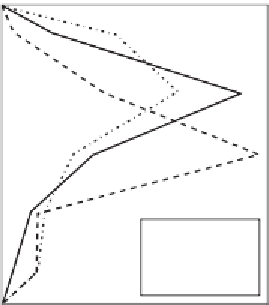Geoscience Reference
In-Depth Information
1.0
1.0
0.8
0.8
0.6
0.6
0.4
0.4
27 June
30 June
6July
0.2
0.2
0.0
0.0
0.
00 0 .5
.5
1.
2.0 .5
3.0
0.0 .1 0.2 .3 0.4 .5
Relative distribution of dew (-)
ah
c
/LAI (-)
Figure 6.25
Dew formation in a maize canopy (data from Jacobs et al. (
1990
). (Left)
Normalized leaf area distribution
ah/LAI
(
a
is the one-sided leaf area per unit vol-
ume;
h
is canopy height) for three dates. (Right) Normalized dew proiles (normal-
ized with the total amount of dew) for the period June 22 to July 5; the area indicates
the range from minimum to maximum value and total amounts of dewfall ranged
from 0.05 to 0.25 mm per night.
development (e.g., Huber and Gillespie,
1992
). Furthermore, surface wetness plays a
role in the deposition of atmospheric trace gases that are well-soluble in water, such
as NH
3
and SO
2
(Wichink Kruijt et al.,
2008
).
In
Section 7.4
a method to quantify the amount of dewfall is discussed.
Question 6.11:
Consider a maize canopy. The canopy has a height of 2 m and the air
temperature within the canopy is 10 °C. A typical amount of dewfall for this night is
0.25 mm in one night.
a) Does all dewfall originate from the air inside the canopy? To answer this, assume
that there is no exchange of water vapour with the soil or the overlying air (the
canopy would be a closed box). Then how much dewfall would be possible if we
assume that all water vapour in the air would condensate on the leaves? Assume the
initial relative humidity of the air to be 100% (and assume
p=
101 300 Pa).
b) What net energy lux density (
Q*- H - G
) would be needed to allow a dewfall of
0.25 mm in a night of 8 hours length?
c) If the aforementioned dewfall of 0.25 mm per night is extracted from a layer 100 m
deep, which was initially isothermal and saturated at 10 °C, what will be the mean
mixing ratio at the end of the night (ignore the change of temperature in the layer
during the night)? Assume an air density of 1.24 kg m
-3
.
6.7 Rainfall Interception
Interception is the process by which precipitation falls on vegetative surfaces, where
it is subject to evaporation. Interception loss depends strongly on (1) vegetation type
























































Search WWH ::

Custom Search